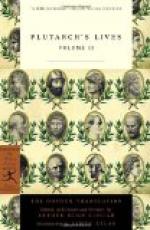XVII. From Lebadeia[233] and the oracle of Trophonius favourable omens and predictions of victory were sent to the Romans, about which the people of the country have a good deal to say. But Sulla, in the tenth book of his Memoirs, writes, that Quintus Titius, a man of some note among those who had mercantile affairs in Greece, came to him immediately after the victory in Chaeroneia, to report that Trophonius foretold a second battle and victory there in a short time. After Titius, a soldier in his army, named Salvenius, brought an answer from the god, as to what would be the result of affairs in Italy. Both reported the same as to the vision[234] of the god: they said, that in beauty and stature he was like the Olympian Jupiter. After crossing the Assus and advancing to the foot of Hedylium, Sulla encamped near Archelaus, who had thrown up a strong intrenchment between Mounts Akontium and Hedylium, at a place called the Assia. The spot on which he encamped is called Archelaus from his name up to the present day. After the interval of one day Sulla left Murena[235] with one legion and two cohorts, to annoy the enemy if he should attempt to form in order of battle; he himself sacrificed on the banks of the Kephisus, and the victims being favourable, he advanced towards Chaeroneia with the object of again effecting a junction with the forces there, and examining the place called Thurium, which was occupied by the enemy. This is a rough summit and a conical-shaped hill, named Orthopagus; and under it is the stream of the Morius and a temple of the Thurian Apollo. The deity has this name from Thuro, the mother of Chaeron, who is said to have been the founder of Chaeroneia. Some say that the cow which was given by the Pythian Apollo as a guide to Kadmus[236] appeared there, and that the place was so called from her; for the Phoenicians call the cow Thor. As Sulla was approaching Chaeroneia, the tribune who was stationed in the city led out the soldiers under arms, and met him with a chaplet of bay. No sooner had Sulla received the chaplet, and after saluting the soldiers, encouraged them to the approaching battle, than two Chaeroneians (Homoloichus and Anaxidamos) presented themselves to him and undertook to drive the enemy from Thurium if he would give them a few soldiers. They said there was a path unknown to the barbarians, leading from the place called Petrachus by the Museum[237] to the highest point of Thurium, and that by taking this direction they could, without difficulty, fall on the enemy and either roll stones down upon them from above or drive them into the plain. As Gabinius bore testimony to the courage and fidelity of the men, Sulla bade them make the attempt; and in the mean time he formed his line and distributed his cavalry on each flank, himself taking the right and giving Murena the command on the left. The legati Galba[238] and Hortensius, with some reserved cohorts in the rear, occupied the neighbouring heights, to prevent the army from being attacked on the flank, for it was observed that the enemy were placing a strong body of cavalry and light infantry on their wings, with the view of adapting that part of their battle to ready and easy manoeuvres, their design being to extend their line and to surround the Romans.




